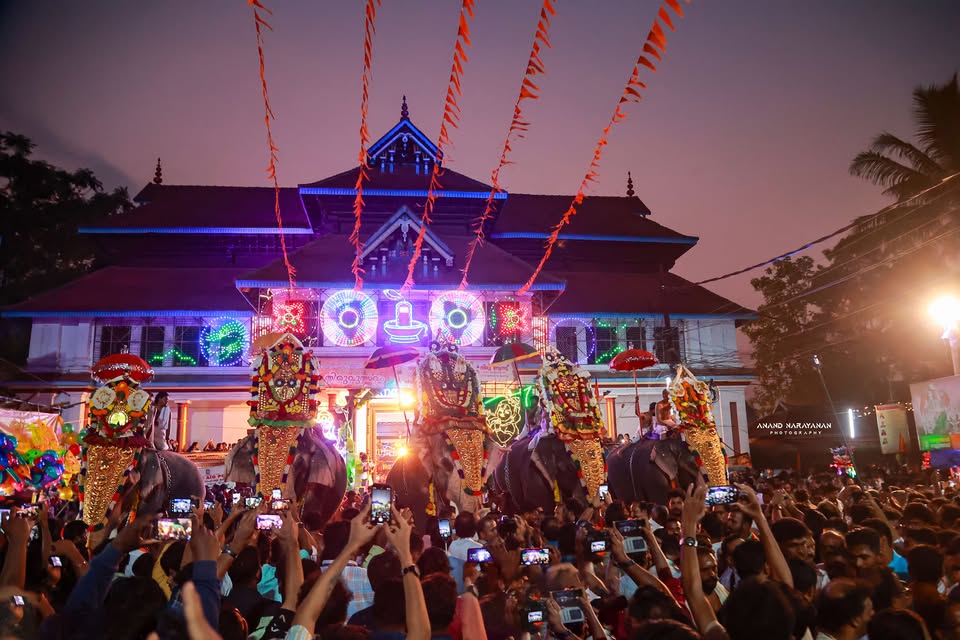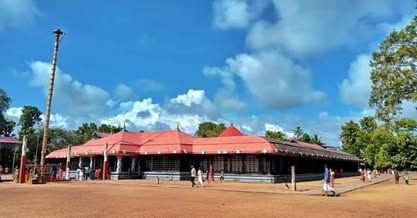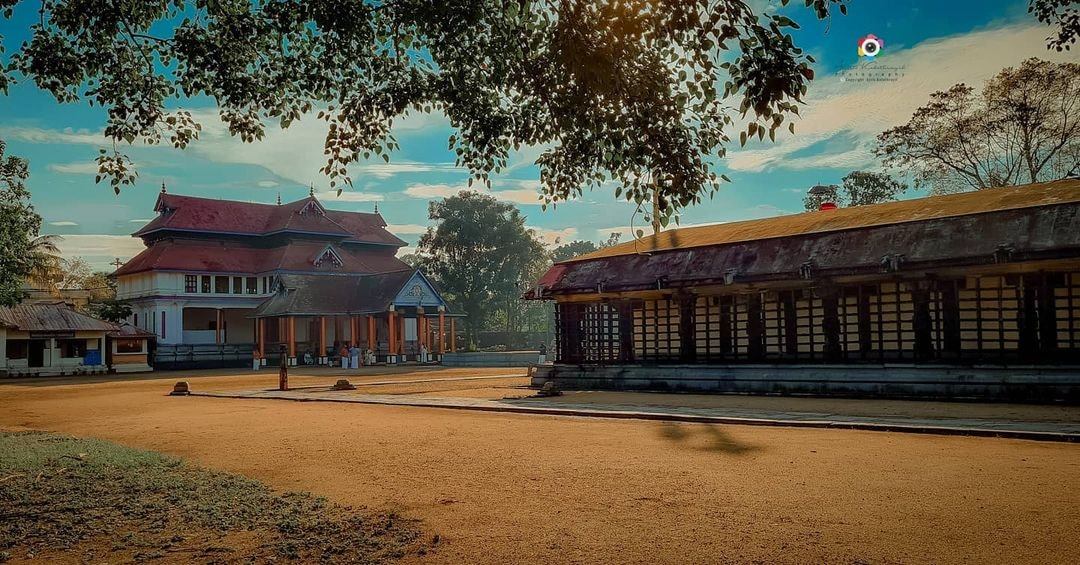Chengannur Mahadeva Temple is renowned as one of the oldest and most significant temples. The principal deities worshipped at this temple are Lord Shiva and Parvathi Devi.

Chengannur Mahadeva Temple, also known as Bhagavathy Temple, is a significant Hindu shrine dedicated to Lord Shiva, situated in the town of Chengannur in the southern Indian state of Kerala. This temple ranks among the foremost Shiva temples in Kerala, alongside notable sites such as the Ettumanoor Mahadevar Temple, Kaduthruthy Mahadeva Temple, Vaikom Temple, Ernakulam Shiva Temple, and Vadakkunnathan Temple.
The goddess Parvati is also venerated with equal reverence. Within the temple complex, there are altars dedicated to various deities, including Ganesha, Dakshinamurti, Subrahmanya, Shasta, Krishna, Nilagriva, Sthalisha, Hanuman, Ganga, and serpent deities, both inside and outside the premises. The temple observes a unique menstruation festival dedicated to Parvathi, known as Thripputhu (Malayalam: തൃപ്പൂത്ത്). During this event, the temple remains closed for three days to honor the deity's irregular menstruation. Five daily pujas are conducted within the temple, comprising three sarabalies for Shiva and three for Parvati. The tantric rituals are overseen by a representative from the Thazhamon Madom family. Additionally, the annual festival (vaarshika ulsavam) takes place from December to January, spanning a duration of 28 days.
The administration of the temple is managed by the Travancore Devaswom Board. It is commonly held that Parvati, the wife of Shiva, arrived at this location following their marriage in the Himalayas. Parvati experienced her menstrual cycle for a duration of 28 days. Bhadrakali is regarded as a reincarnation of Sati, whose Kamakhya Temple is situated to the north. An alternative version of this legend suggests that the sage Agastya, who was unable to attend the divine union of Shiva and Parvati, was later visited by the couple. Due to Parvati's menstruation, she chose to wait for 28 days before granting darshan to the sage.
The temple is situated in the center of Chengannur, in close proximity to the Pamba River. This town is recognized as one of the 32 Namputiri towns in Kerala, with Mahadeva (Shiva) regarded as its patron deity. The main idol of Mahadeva, represented in the form of a lingam, is oriented towards the east, while the statue of his consort Bhadrakali is positioned behind it, facing west. Access to the temple is gained through a temple tower constructed in the traditional Kerala architectural style, alongside a golden flagstaff, both aligned with the central shrine. Surrounding the temple in the second precinct are shrines dedicated to Shasta and Nilagriva, while the first precinct features an image of Ganesha. The statue of Bhadrakali is crafted from panchaloha, an alloy composed of five metals, and it is believed that Perumachuten brought this image to the temple.
The temple exemplifies the distinctive Kerala-style architecture, prevalent among temples in the South Indian state of Kerala. It features a two-storeyed gopuram, or gateway tower, with the upper level adorned with wooden rails that enclose the kottupura, a hall designated for drum performances during festivals. Surrounding the temple's shrines is a rectangular wall known as the kshetra-madilluka, which is punctuated by gateways. The metal-plated flagstaff, or dvajasthambam, is aligned with the temple tower, leading towards the central sanctum, while a deepastambha, serving as a lamp post, is also present. The chuttambalam functions as the outer pavilion within the temple precincts. The central shrine, along with its adjoining hall, is situated within a rectangular structure referred to as nalambalam.
A raised square platform, known as the namaskara mandapa, featuring a pyramidal roof, is positioned between the nalambalam entrance and the sanctum. To the left of the namaskara mandapa, as one enters, lies the thevrapura, the kitchen responsible for preparing offerings to the deity. The balithara serves as an altar for ritualistic offerings to demigods and festive deities. The central shrine, termed sri-kovil, enshrines the image of the presiding deity and is elevated on a platform accessed by a flight of five steps. Guardian deities, known as Dvarapalakas, are depicted on either side of the entrance doors. According to Kerala's rituals, only the chief priest, referred to as Thantri, and the second priest, known as Melshanthi, are permitted to enter the sri-kovil. The central shrine is designed with a circular plan, featuring a granite base, a laterite superstructure, and a conical roof made of terracotta tiles, supported internally by a wooden framework.
The lower section of the sri-kovil comprises the basement, the pillar or wall, termed stambha or bhithi, and the entablature known as prasthara, arranged in a height ratio of 1:2:1. The upper section mirrors this division, consisting of the neck called griva, the roof tower known as shikhara, and the finial kalasam, crafted from copper, all maintaining the same ratio. The roof extends in two levels to provide protection for the inner structure. Five daily pujas are conducted at the temple, comprising three sarabalies dedicated to Shiva and three for Bhadrakali. The Tantric rituals are performed by a member of the Thazhamon family. A unique menstruation festival, known as Thripputhu, is celebrated for Bhadrakali, during which the temple remains closed for three days to honor the deity's irregular menstruation.
The emergence of a stain on the white garment is regarded as a sign of devotion. According to temple officials, this phenomenon is currently observed once every three to four months, in contrast to its more frequent occurrence in the past. The ceremony bears resemblance to the puberty rites of high-class girls in Kerala. The sri-kovil is closed for the duration of the three days and is reopened following a purification ceremony on the fourth day. Thiruppooth Aratt is a festival observed at the temple on at least three occasions each year, during which the festival icons of Mahadeva and Bhadrakali are paraded on ornately adorned elephants to the Pamba River.
A sacred immersion, known as arat, is performed for the icons before they are returned to the temple. Female devotees participate in the procession by carrying traditional thalappoli lamps. The event is further enhanced by the presence of a temple orchestra and panchavadyam. The principal festivals at the temple include the flag hoisting ceremony in the Thiruvathirai month of Dhanu and Aaraattu during the Thiruvathirai month of Makaram. The annual festival takes place from December to January and spans a duration of 28 days.
ചെങ്ങന്നൂർ മഹാദേവ ക്ഷേത്രം
ചെങ്ങന്നൂർ നഗരത്തിൽ, ആലപ്പുഴ ജില്ലയിൽ സ്ഥിതിചെയ്യുന്ന പുരാതനവും ചരിത്രപരമായ ക്ഷേത്രമാണ് ചെങ്ങന്നൂർ മഹാദേവ ക്ഷേത്രം. ഇത് ചെങ്ങന്നൂർ ശിവപാർവതി ക്ഷേത്രം അല്ലെങ്കിൽ ചെങ്ങന്നൂർ ഭഗവതി ക്ഷേത്രം എന്ന പേരിലും അറിയപ്പെടുന്നു. ഹൈന്ദവ ശൈവ വിശ്വാസപ്രകാരം, ഈ ക്ഷേത്രത്തിലെ പ്രധാന പ്രതിഷ്ഠകൾ മൃത്യുവിജയിയായ പരമശിവനും ആദിപരാശക്തിയായ ശ്രീ പാർവതിയുമാണ്. മഹാദേവനെ കിഴക്കുഭാഗത്തും ഭഗവതിയെ പടിഞ്ഞാറുഭാഗത്തും അഭിമുഖമായി ഒരേ ശ്രീകോവിലിൽ അർദ്ധനാരീശ്വര സങ്കൽപ്പത്തിൽ പ്രതിഷ്ഠിച്ചിരിക്കുന്നു. ഇവിടെ ഭഗവതിക്ക് ശിവനേക്കാൾ കൂടുതൽ പ്രസിദ്ധി ഉള്ളതിന്റെ പ്രത്യേകതയും കാണപ്പെടുന്നു.
ചെങ്ങന്നൂർ ആസ്ഥാനമാക്കി ഭരിച്ച വഞ്ഞിപ്പുഴ തമ്പുരാക്കന്മാരുടെ കാലത്ത്, ഇന്ന് കാണുന്ന രീതിയിൽ ക്ഷേത്രം നിർമ്മിച്ചതാണെന്ന് കരുതപ്പെടുന്നു. കേരളത്തിലെ നൂറ്റെട്ട ശിവക്ഷേത്രങ്ങളിൽ കുംഭസംഭവമന്ദിരം എന്നറിയപ്പെടുന്നത് ചെങ്ങന്നൂർ ക്ഷേത്രമാണ്. എന്നാൽ, മഹാദേവനേക്കാൾ ഭഗവതിക്ക് കൂടുതൽ പ്രാധാന്യം ഉള്ള ക്ഷേത്രമാണിത്. ആദിപരാശക്തിയായ ഭഗവതി, സ്വയംവര പാർവതി, മഹാകാളി, സതി തുടങ്ങിയ രൂപങ്ങളിൽ ഇവിടെ ആരാധിക്കപ്പെടുന്നു. ഇവിടെ പാർവതീദേവിയുടെ തൃപ്പൂത്താറാട്ട് വളരെ പ്രശസ്തമാണ്. ചെങ്ങന്നൂരമ്മ രജസ്വലയാകുന്നു എന്ന ആശയത്തിൽ ഇത് സ്ഥിതിചെയ്യുന്നു. തുടർന്ന്, പന്ത്രണ്ടു ദിവസത്തെ ഭഗവതീ ദർശനം സർവ ഐശ്വര്യത്തിനും ആഗ്രഹ സാഫല്യത്തിനും ഏറ്റവും അനുയോജ്യമാണ് എന്നതാണ് വിശ്വാസം. ഈ സമയത്ത് ഹരിദ്ര പുഷ്പാഞ്ജലി പ്രധാനമായ വഴിപാട് ആണ്.
ഈ ക്ഷേത്രത്തിന്റെ പ്രത്യേകതകൾ മറ്റ് ക്ഷേത്രങ്ങളിൽ കാണാനാവില്ല. നൂറ്റെട്ട് ശിവാലയങ്ങളിൽ ഉൾപ്പെടുന്ന ഈ ക്ഷേത്രം പരശുരാമൻ സ്ഥാപിച്ചതാണെന്നു പറയപ്പെടുന്നു. പരാശക്തിയുടെ സമാന പ്രാധാന്യം ഉള്ളതിനാൽ, നൂറ്റെട്ട് ദുർഗ്ഗാക്ഷേത്രങ്ങളിലും ചെങ്ങന്നൂരിൽ ഈ ക്ഷേത്രം കാണപ്പെടുന്നു. ഗണപതി, ദക്ഷിണാമൂർത്തി, അയ്യപ്പൻ, സുബ്രഹ്മണ്യൻ, ശ്രീകൃഷ്ണൻ, ഗംഗാദേവി, നീലഗ്രീവൻ, സ്ഥലീശൻ, ചണ്ഡികേശ്വരൻ, ഹനുമാൻ, നാഗദൈവങ്ങൾ എന്നിവയെ ഉപദേവതകളായി ഇവിടെ പ്രതിഷ്ഠിച്ചിട്ടുണ്ട്. തിരുവിതാംകൂർ ദേവസ്വം ബോർഡിന്റെ കീഴിലാണ് ഈ മഹാക്ഷേത്രം പ്രവർത്തിക്കുന്നത്. ധനുമാസത്തിലെ തിരുവാതിരയ്ക്ക് കൊടിയേറി, മകരമാസത്തിലെ തിരുവാതിരയ്ക്ക് അവസാനിക്കുന്ന 28 ദിവസത്തെ മഹോത്സവം (മറ്റൊരു ക്ഷേത്രത്തിൽ കാണാൻ സാധിക്കാത്ത പ്രത്യേകത), പ്രതിമാസ ഉത്രം നാളിലെ "ഉത്രം തൊഴീൽ", നവകാഭിഷേകം, കന്നിമാസത്തിലെ നവരാത്രി ഉത്സവം, വിദ്യാരംഭം, കുംഭമാസത്തിലെ ചടങ്ങുകൾ എന്നിവയും ഇവിടെ നടത്തപ്പെടുന്നു.
പാർവ്വതീപരമേശ്വരന്റെ വിവാഹത്തിൽ ബ്രഹ്മാവ്, വിഷ്ണു, ഇന്ദ്രൻ, ലക്ഷ്മി, സരസ്വതി തുടങ്ങിയ ദേവന്മാരും മഹർഷിമാരും പങ്കെടുത്തിരുന്നു. ഇവരുടെ ഭാരം കാരണം ഭൂമി ചരിഞ്ഞുപോകുമെന്ന ഭയം എല്ലാവരുടെയും മനസ്സിൽ ഉണ്ടായിരുന്നു. ഈ പ്രശ്നത്തിന് പരിഹാരമായി ഭഗവാൻ അഗസ്ത്യമുനിയെ തെക്കുഭാഗത്ത് ഇരുത്തി. ഉയരം കുറഞ്ഞ ശരീരമുള്ള അഗസ്ത്യമുനി ഭൂമിയുടെ ചരിവ് എങ്ങനെ പരിഹരിക്കുമെന്നതിൽ ദേവന്മാർക്കുണ്ടായ സംശയം തീർന്നു. എന്നാൽ, തെക്കുഭാഗത്തെ ശോണാദ്രിയിൽ (ഇന്നത്തെ ചെങ്ങന്നൂർ) തപസ്സിനിടയിൽ അഗസ്ത്യമുനി ഭൂമിയെ ചരിയാതെ നിലനിർത്തി. തന്റെ ദിവ്യദൃഷ്ടി കൊണ്ട് മുനി ശിവപാർവ്വതീപരിണയം കണ്ടു. വിവാഹശേഷം ഭഗവാൻ പാർവ്വതീസമേതനായി അഗസ്ത്യമുനിയെ കാണാൻ ശോണാദ്രിയിലെത്തി. അവിടെ ദേവിയ്ക്ക് ഋതുവുണ്ടാകുകയും, തുടർന്ന് ഋതുശാന്തിവിവാഹം നടത്തുകയും ചെയ്തു.
അഗസ്ത്യമഹർഷി ശിവപാർവ്വതീസ്വയംവരത്തിൽ പങ്കെടുക്കാത്തതിൽ അനുഭവിച്ച ദുഃഖം അവസാനിച്ചു. ഋതുശാന്തികല്യാണം നടന്ന സ്ഥലത്ത്, ക്ഷേത്രത്തിലെ ദേവീചൈതന്യം പ്രസരിക്കുന്ന ശക്തിതീർത്ഥം എന്നറിയപ്പെടുന്ന തീർത്ഥക്കുളം സ്ഥിതിചെയ്യുന്നു. ഈ കുളത്തിന്റെ അടിയിൽ, ഋതുശാന്തികല്യാണം നടത്തിയ അഗസ്ത്യരുടെ ഹോമകുണ്ഡത്തിന്റെ അവശിഷ്ടങ്ങൾ നിലനിൽക്കുന്നു എന്നതാണ് ഐതിഹ്യം. ഇവിടെ മീനൂട്ട് വഴിപാട് നടത്തപ്പെടുന്നു. തനിക്ക് പൂജ നടത്താൻ എന്നും കുടികൊള്ളണമെന്ന അഗസ്ത്യമഹർഷിയുടെ അഭ്യർത്ഥനയെ തുടർന്ന്, ശിവപാർവ്വതിമാർ സ്വയംഭൂവായി ചെങ്ങന്നൂരിൽ അവതരിച്ചു. ഇതാണ് ഇന്ന് ക്ഷേത്രത്തിന്റെ വടക്കുകിഴക്കുഭാഗത്ത് കാണപ്പെടുന്ന മൂലക്ഷേത്രമായ കുന്നത്ത് മഹാദേവക്ഷേത്രം.
ചെങ്ങന്നൂർ ക്ഷേത്രദർശനം പൂർണ്ണമാകണമെങ്കിൽ, ഇവിടെയും ദർശനം നടത്തേണ്ടതുണ്ട്. കുന്നത്ത് മഹാദേവൻ കുട്ടികളോടുള്ള വാത്സല്യത്തിന് പ്രശസ്തനാണ്. അതിനാൽ, ഈ ക്ഷേത്രത്തിൽ കുട്ടികളെ കൊണ്ടുവരുന്നത് ബാലാരിഷ്ടം മാറാൻ നല്ലതാണെന്ന് ഭക്തർ വിശ്വസിക്കുന്നു. ഈ ഉദ്ദേശ്യത്തോടൊപ്പം നടത്തുന്ന പ്രത്യേക വഴിപാടാണ് "കൊട്ടും ചിരിയും". (കുട്ടികൾക്ക് ഇഷ്ടമുള്ള മധുര ഭക്ഷണങ്ങളും ഫലങ്ങളും പൂജിച്ച് വിതരണം ചെയ്യുന്നു. ഈ സമയത്ത് കുട്ടികൾ കൈകൊട്ടി ചിരിക്കുന്നു. സന്താനലാഭത്തിനും കുട്ടികളുടെ രോഗദുരിതം ശമിപ്പിക്കുന്നതിനും ആയുസ്സിനും വേണ്ടി ഈ പ്രശസ്തമായ വഴിപാട് നടത്തപ്പെടുന്നു.) സ്വയംവരത്തിനുശേഷം ബ്രഹ്മാദികൾ പിരിഞ്ഞുപോകുകയും സ്ഥലം കാടുപിടിച്ച് ദീർഘകാലം കിടക്കുകയും ചെയ്തു.
Address:
Kizhakke Nada,
Chengannur, Kerala 689121



